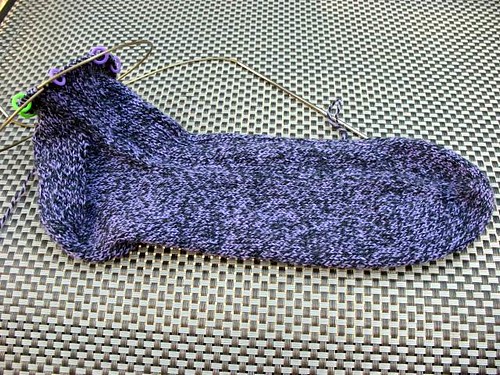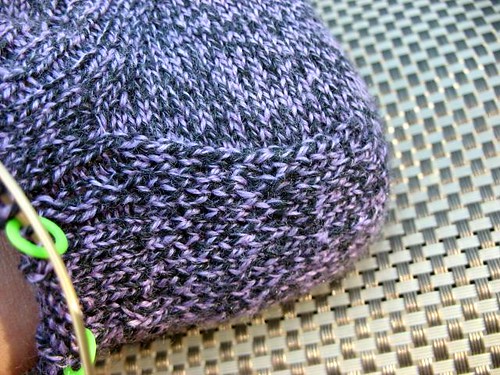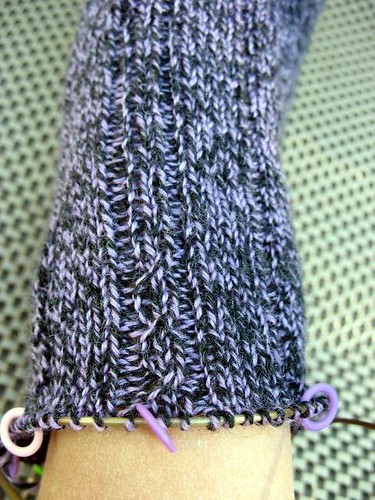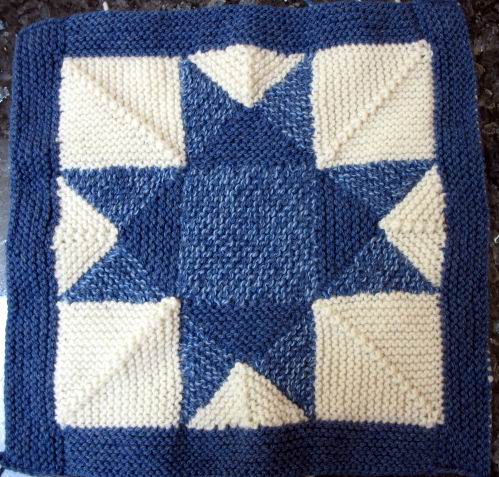Widdershins Hell Heel
When I first typed in the title of the heel photo to upload to Flickr, I accidentally typed in "Widdershins Hell", which is an apt description of my weekend.
However, I have finally tamed that bad boy, and here is the good progress I am making on my brother's sock:
Here is my Widdershins heel, with which I am very pleased:
Look, Ma, no holes!
And here you can see the fetching little cable design I have started on the leg portion:
This sock is at 9 st./in., and is for my brother, so it's 72 stitches around. The Widdershins pattern is for a women's sock at 7 st./in., so it's 54 stitches around. You all know what this meant -- math!
This post by the designer of the Widdershins pattern explains a bit of the process she went through in designing the heel, and was very helpful. However, this part: "I actually came up with an equation to figure out the approximate number of heel stitches. For a round heel with a flap n stitches wide, the number of stitches below the heel turning is h(n) where h(k) = k for k is less than n/3 and 4+h(k-6) otherwise", made no sense to me at all.
Now, I don't consider myself math-phobic, or even math-impaired on most days. I took calculus, got an A in it, too. I even took an extra math class in high school that met before school. For three whole years, people. I'm geeky enough to have knit Moebius scarves with Fibonacci stripe sequences, and a Klein bottle hat, you may recall. But, WTF?
So I had to resort to staring at the completed BIL sock heel and figuring out its construction (blindly following the pattern resulted in a nice sock heel, but no real understanding on my part as to how it was constructed), and then -- math. I spent hours (well, while watching a movie, too) figuring out the stitch counts on various pieces of the Widdershins heel, and what the corresponding counts should be on my heel, and how they would be joined together, fiddled with it yet a bit more after waking up the next morning, tinked the mess I had tried earlier, and then -- knit the heel. And hallelujah, it worked! I have given the heel back a lovely eye-of-partridge stitch pattern, taken the Madder rib pattern I did on the top of the foot all the way around the leg, and started a tiny 2-stitch cable pattern to mimic the look of the Kilt Hose leg pattern that I had tried and rejected, but without the holes that I was disliking so much.
Some time later I'll post the numbers I used, when I have knit the second sock and have more confidence in them (a tiny bit of fudging was required in this one, which could perhaps be worked out a bit better in the second sock).
The main "aha" moment was when I realized that a top-down sock has a heel turn that decreases a portion of the heel flap stitches down to some smaller number of stitches, thus knitting a little triangular (or, more geekily precisely, trapezoidal) piece that creates the little cup at the base of the heel, and that this sock's heel turn would need to reverse that process, increasing where the other one decreased.
This is Lang Jawoll fingering weight yarn, colors lavender and black (and yes, my brother requested lavender as the color of his to-be-determined knitted item). I am using one Addi Turbo 40" circ., size US1, magic-loop style.
This is a very nice heel, but would I use it again? I don't know yet. The main purpose of this design seems to be avoiding picking up stitches, since there are other toe-up flap-and-gusset heel designs out there, but you have to pick up stitches. On the other hand, it is nice-looking, and now that I've done the math . . .

3 Comments:
You are one smart cookie...I bow in reverence:)
Ang
By Angela, at Wednesday, October 25, 2006 9:20:00 AM
Angela, at Wednesday, October 25, 2006 9:20:00 AM
I love that yarn. Nice and masculiine, but fun. He'll love 'em!
By Laura, at Thursday, October 26, 2006 11:43:00 AM
Laura, at Thursday, October 26, 2006 11:43:00 AM
http://www.knittyboard.com/viewtopic.php?t=43954
Love this post. I tried calculating multipliers for Widdershins a la Zimmerman. Posted it over on the knittyboard. See what you think?
Love, love, love these socks. Lucky brother!
By Julie, at Wednesday, November 22, 2006 2:32:00 PM
Julie, at Wednesday, November 22, 2006 2:32:00 PM
Post a Comment
<< Home